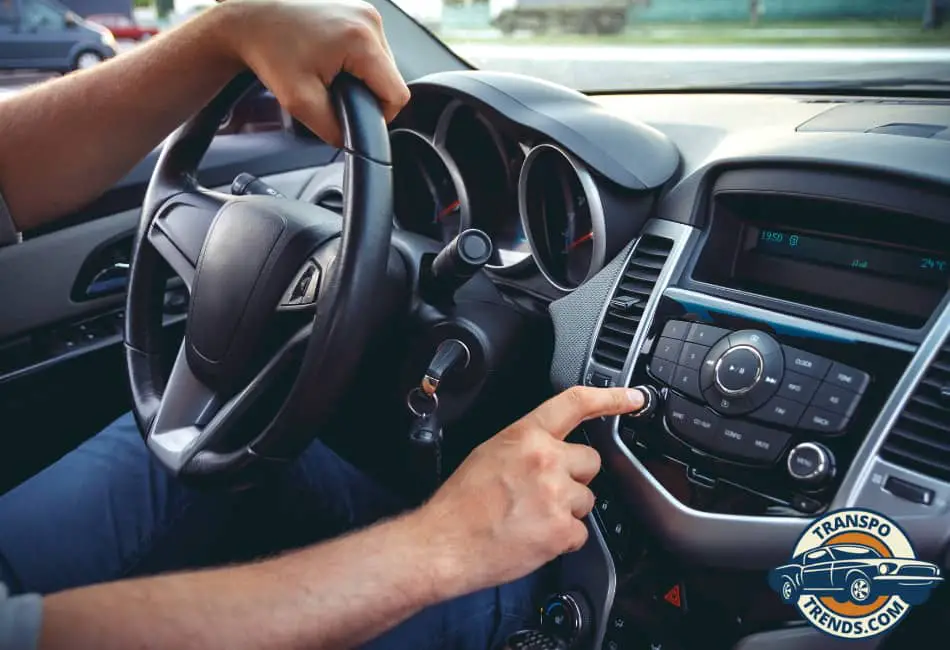Dashboard lights in a vehicle are vital indicators of the overall health and functionality of the car. They alert drivers to potential issues, ranging from low fuel to serious mechanical problems that require immediate attention. Ignoring these indications could lead to more severe, sometimes dangerous situations.
However, when dashboard lights flicker or illuminate unexpectedly, it can lead to confusion and concern. These anomalies may indicate underlying issues and shouldn’t be overlooked.
In this guide, we will explore the seven main reasons for these issues, including faulty sensors, engine problems, fuel system complications, environmental factors, software and computer glitches, the importance of routine maintenance and preventive measures, and the role of critical vehicle systems. Understanding these reasons is crucial for safe and efficient vehicle operation.
Reasons Dashboard Lights Go on and off While Driving
1. Electrical System Problems
Alternator Issues and Their Impact on Dashboard Lights
The alternator is an essential component of the vehicle’s electrical system, responsible for charging the battery and powering the electrical features when the car is running.
If the alternator is faulty, you may notice your dashboard lights becoming dim, flickering, or not coming on at all.
This is because the alternator is not providing adequate power, causing the lights to behave erratically.
Battery Problems Leading to Erratic Dashboard Light Behavior
The car’s battery is another crucial element in the functioning of the dashboard lights. If your car battery is low or there is a problem with the battery connections, it can cause the dashboard lights to blink or sometimes even stay on when the vehicle is off.
Using a digital car battery tester is a quick way to confirm if a weak or failing battery is the real culprit behind flickering dashboard lights.
This indicates that the battery does not supply consistent power to the dashboard lights, leading to anomalous behavior.
Wiring Faults Causing Intermittent Illumination
Wiring faults can cause intermittent dashboard light illumination. If the dashboard lights flicker or randomly switch on and off, it could be due to a loose connection or a frayed wire in the electrical system.
Such issues should be addressed promptly to prevent further electrical system damage.
2. Faulty Sensors
Faulty sensors in a vehicle can cause irregular dashboard light behaviors, often signaling a problem that needs immediate attention.
Vehicles today have many sensors playing crucial roles in maintaining optimal performance, safety, and efficiency.
These sensors monitor a wide range of vehicle conditions and directly influence the behavior of dashboard lights.
When these sensors malfunction, the related dashboard light may start to flicker, stay on, or in some cases, not light up at all.
Malfunctioning ABS Sensors and the ABS Light
The Anti-lock Braking System (ABS) sensors play a pivotal role in maintaining the vehicle’s safety.
When an ABS sensor malfunctions, the ABS warning light on the dashboard gets activated, alerting the driver of potential braking problems.
Regular maintenance and timely repair of these sensors are necessary to ensure a safe driving experience.
Failing Airbag Sensor on the SRS Light
The airbag sensors are responsible for deploying airbags during a collision. A faulty airbag sensor can cause the SRS (Supplemental Restraint System) light on the dashboard to stay on, indicating a problem with the airbag system.
This is a serious issue as it could mean the airbags may not deploy in an accident, compromising the safety of the occupants.
Tire Pressure Monitoring System (TPMS) Sensor
The TPMS sensor continuously monitors the tire pressure in a vehicle. A malfunctioning TPMS sensor can lead to the TPMS light staying illuminated, signaling low tire pressure when, in fact, the tire pressure might be adequate.
Regular checks and timely replacement of the TPMS sensor can prevent such issues, ensuring accurate tire pressure readings and optimal vehicle performance.
3. Engine Problems
Engine Misfires and the Check Engine Light
Engine misfires can be expected in vehicles, but frequent and unaddressed misfires can lead to severe engine damage.
A misfiring engine is often associated with the Check Engine light on the dashboard. This light activates when the vehicle’s onboard computer detects an issue within the engine.
It could be due to various reasons, including failing spark plugs, a malfunctioning fuel injector, or even a worn timing belt.
Regular vehicle maintenance and immediate attention to a lit Check Engine light can help prevent misfires and more serious engine problems.
Overheating Engine Triggering the Temperature Warning Light
The engine cooling system plays a crucial role in maintaining the optimum operating temperature of the vehicle’s engine.
When the engine overheats, the Temperature Warning light on the dashboard activates, signaling that the engine is running too hot.
This could be due to a leak in the cooling system, a malfunctioning radiator fan, a clogged coolant hose, or a failing water pump.
Ignoring this warning light can lead to significant engine damage. Therefore, checking the cooling system regularly and promptly addressing any issues is essential.
Low Engine Oil Pressure and its Association with the Oil Pressure Light
Oil is the lifeblood of an engine, providing lubrication for its various parts and helping to dissipate heat.
When the engine oil pressure is low, it can cause increased friction between engine components, leading to overheating and potential engine failure.
The Oil Pressure light on the dashboard is linked to the oil pressure sensor and illuminates when it detects low oil pressure.
This could be due to a low oil level, a failing oil pump, or a blockage in the oil filter or oil galleries.
Regular oil changes and immediate attention to a lit Oil Pressure light can help alleviate these issues and extend the engine’s life.
4. Fuel System Complications
Fuel Cap Causing the Check Engine Light to Turn On
A loose or missing fuel cap is a commonly overlooked issue that can trigger the Check Engine light.
The fuel cap ensures a sealed environment, preventing fuel vapors from escaping and maintaining the pressure within the fuel tank.
If the fuel cap is loose or missing, the pressure within the fuel tank drops. The vehicle’s onboard diagnostic system detects this pressure drop and, in response, activates the Check Engine light.
Regularly checking the tightness of the fuel cap and replacing it if it’s damaged or missing can help prevent this issue.
Fuel Injection System Irregularities
The fuel injection system plays a vital role in a vehicle’s performance by controlling the fuel’s delivery to the engine.
Irregularities in the fuel injection system, such as clogged injectors, leaking injectors, or issues with the electronic control unit (ECU), can lead to poor engine performance and trigger dashboard warning lights.
Regular inspections and maintenance of the fuel injection system, including cleaning or replacing clogged injectors and ensuring the ECU is functioning correctly, can help mitigate these problems and enhance vehicle performance.
5. Environmental Factors
Temperature and Humidity Affect Dashboard Light Behavior
Temperature and humidity drastically influence the behavior of dashboard warning lights. Electronics in the instrument cluster are sensitive to temperature changes.
High temperatures can cause solder joints to crack, leading to intermittent or permanent failure of dashboard lights.
Conversely, in colder temperatures, the liquid crystal display (LCD) can slow down or become unresponsive, making it hard to read the warnings.
Humidity brings another set of challenges. High humidity levels can lead to condensation build-up inside the electronic components, which can cause corrosion or short-circuits, resulting in erratic behavior or failure of dashboard lights.
Condensation & Moisture Buildup in the Instrument Cluster
Condensation and moisture buildup in the instrument cluster can severely impact the functionality of dashboard warning lights.
To address this, it’s essential to maintain a sealed environment in the cluster. If condensation becomes an issue, using a dehumidifier in the vehicle or parking in a dry location can help reduce moisture buildup.
If the problem persists, it may be necessary to disassemble the instrument cluster to remove any moisture and check for damages.
In some cases, a replacement may be needed. A professional mechanic or technician can help diagnose and repair such issues, ensuring the reliable operation of dashboard warning lights.
Regular inspections for condensation and moisture are crucial, especially in more humid climates, to prevent permanent damage to the vehicle’s electronic systems.
6. Software and Computer Glitches
- Software Bugs or Updates Causing Dashboard Light Anomalies
Software bugs or out-of-date software can also lead to anomalies in the operation of dashboard lights.
The modern vehicle relies on an intricate network of software and sensors to monitor vehicle performance and convey information to the driver.
Should this software experience bugs or fail to update correctly, drivers may notice unexpected dashboard light behavior, such as false warnings or unresponsive lights.
It’s crucial to keep your vehicle’s software up-to-date and check for known bugs or issues regularly.
- Diagnosing Issues with the Onboard Computer System (ECU)
The Engine Control Unit (ECU) serves as the vehicle’s onboard computer system, controlling various functions, including the dashboard warning lights. If there’s a fault in the ECU, it may result in incorrect or random dashboard light activations.
Diagnosing ECU issues requires professional tools and expertise—generally, a mechanic will use diagnostic equipment to interface with the ECU, identify any fault codes, and determine the source of the problem.
If you prefer a DIY first step, a reliable OBD-II scanner can read fault codes from your vehicle’s computer, helping you pinpoint issues before visiting a mechanic.
- Resetting Dashboard Lights After Resolving Software-related Problems
Once any software-related problems have been resolved, it’s generally necessary to reset the dashboard warning lights to clear any lingering error signals.
This procedure varies by vehicle make and model but typically involves using a diagnostic tool to communicate with the vehicle’s ECU.
By resetting the dashboard lights, you ensure that future warnings genuinely indicate new issues rather than echoes of past problems.
Routine Maintenance and Preventive Measures
Maintaining your vehicle’s health isn’t just about responding to dashboard warnings—it’s about proactively preventing issues before they arise.
Importance of Regular Vehicle Inspections and Maintenance
Regular vehicle inspections and maintenance are the cornerstone of preventive vehicle care. They not only prolong the lifespan of your car but also help you avoid unexpected breakdowns and costly repairs.
Regular checks ensure the vehicle’s software is updated and all components work as they should.
The inspections should cover crucial areas such as the engine, brakes, tires, lights, and the onboard computer system. Remember, a well-maintained vehicle is a safer, more reliable, and more efficient vehicle.
Tips for Checking and Addressing Dashboard Light Issues at Home
While professional help may be necessary for diagnosing complex issues, there are steps you can take at home to check for dashboard light issues.
- Familiarize yourself with your vehicle’s owner manual—it contains essential information about what each dashboard symbol signifies.
- If a warning light comes on, don’t ignore it. Investigate right away to prevent potential damage.
- Regularly inspect your vehicle for software updates and promptly install them to ensure the dashboard’s accurate operation.
- When a light comes on, try resetting your vehicle’s computer system by disconnecting and reconnecting the battery. Check the manual for guidance.
Seeking Professional Help When Necessary
However, some issues are beyond a layperson’s ability to resolve. If a dashboard warning light persists despite your troubleshooting efforts, or if you encounter a warning light you do not understand, it’s wise to seek professional assistance.
Mechanics have specialized tools and expertise to accurately diagnose and resolve dashboard light issues, ensuring your vehicle’s continued safety and performance. Don’t hesitate to take your car in for inspection if you’re ever in doubt.

